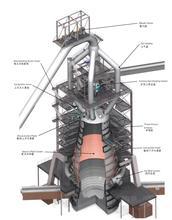 Humidification blast, once called a steam blast, is a technology that adds steam to the blast furnace blast to increase and stabilize the humidity of the blast. Before blasting the fuel, it is one of the important technologies for blast furnace smelting. In the 1950s, Mr. Ye Zhupei, a famous metallurgist in China, combined high-pressure operation, high air temperature and high steam to strengthen blast furnace smelting, and called it the three-high theory.
Humidification blast, once called a steam blast, is a technology that adds steam to the blast furnace blast to increase and stabilize the humidity of the blast. Before blasting the fuel, it is one of the important technologies for blast furnace smelting. In the 1950s, Mr. Ye Zhupei, a famous metallurgist in China, combined high-pressure operation, high air temperature and high steam to strengthen blast furnace smelting, and called it the three-high theory. Blasting humidification plays a role in blast furnace smelting as follows:
The humidification of the blast can be used to keep the humidity of the blast stable and eliminate the adverse effects of atmospheric natural fluctuations on the forward direction of the furnace.
(2) Humidification can reduce the amount of air needed to burn 1 kg of carbon before the tuyere, and reduce the amount of gas produced. Humidity increases by 1%, and gas volume decreases by 0.5%. The smelting intensity can be increased while keeping the AP constant.
(3) If the blast is humidified by 1%, the decomposition of the heat before the tuyere is 10,800 kj/m3 or 13,340 kJ/kg, which will reduce the theoretical combustion temperature and the average temperature of the hearth gas. When the humidity is low, the moisture content per 1% is reduced by ta40$45C, and when the humidity is high, the temperature is lowered by 30-35°C. If it is kept constant, the conditions for using high air temperature create conditions that can increase every 1% moisture content. The air temperature is 60C, and the heat state of the hearth can also be controlled by adjusting the humidity.
(4) After the blasting and humidification, the concentration of C0+H2 in the hearth gas increases, and the N2 content decreases. On the one hand, the reducing ability of the gas is increased, the reduction rate is accelerated, and the indirect reduction is developed, which is beneficial to the reduction of the coke ratio; The increase in enthalpy has reduced the density and viscosity of the gas, and it has also created conditions for blast furnace strengthening without increasing the gas.
After the blast furnace blows fuel, the humidified blast is gradually replaced by the injected fuel. Because the role of fuel injection is greater and more economical than the humidification of the blast, after the large coal injection, not only is it not humidified, but also the blast is performed. Dewetting to take advantage of pulverized coal. But in blast furnaces that do not inject pulverized coal into a full coke smelter, the humidified air blast can still be used as a means of regulating furnace conditions and intensifying smelting.
Bicalutamide is a synthetic, nonsteroidal antiandrogen. Bicalutamide competitively binds to cytosolic androgen receptors in target tissues, thereby inhibiting the receptor binding of androgens. This agent does not bind to most mutated forms of androgen receptors. (NCI04)
Bicalutamide is a nonsteroidal antiandrogen similar in structure to flutamide that is used widely in the therapy of prostate cancer and has been linked to rare instances of liver injury.
Bicalutamide is an oral non-steroidal anti-androgen for prostate cancer. It is comprised of a racemic mixture that is a 50:50 composition of the (R)-bicalutamide and (S)-bicalutamide enantionmers. Bicalutamide binds to the androgen receptor.
Bicalutamide Intermediate,Bicalutamide Intermediate Cas No.654-70-6,Bicalutamdie Intermediate Cas 90357-53-2,Bicalutamdie Intermediate Cas 654-70-6
 Shandong Haohong Biotechnology Co., Ltd. , https://www.haohongpharma.com
